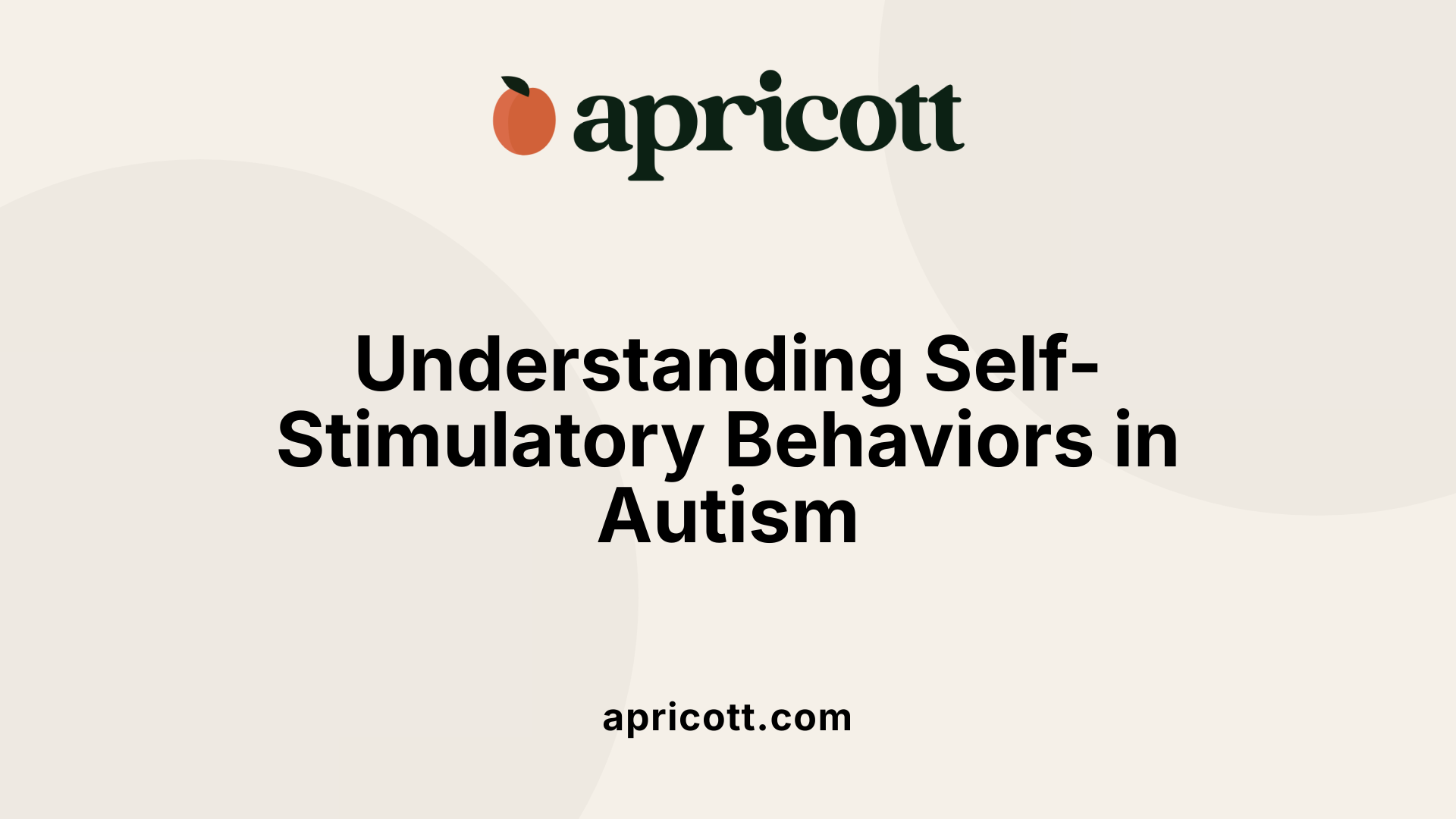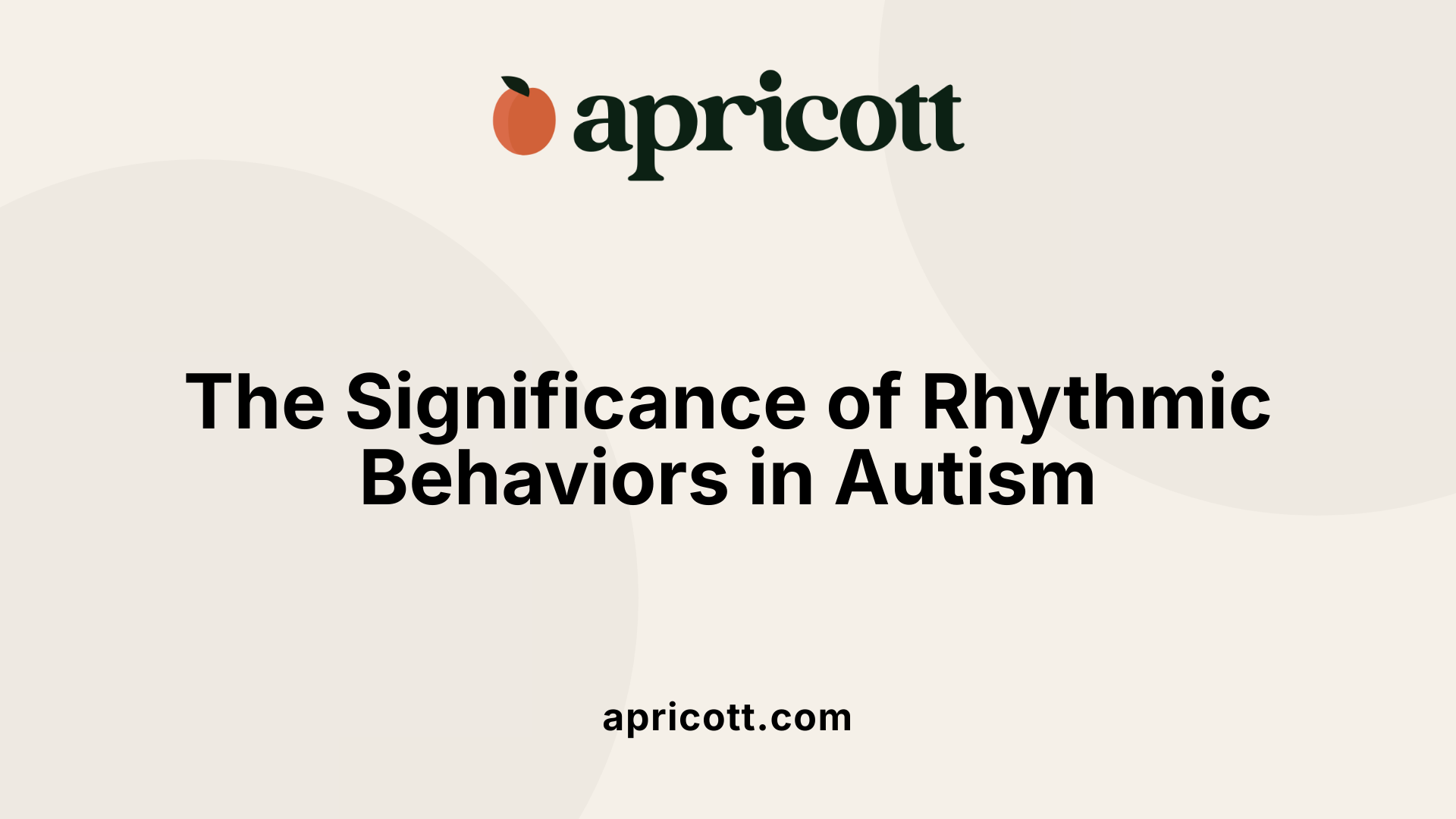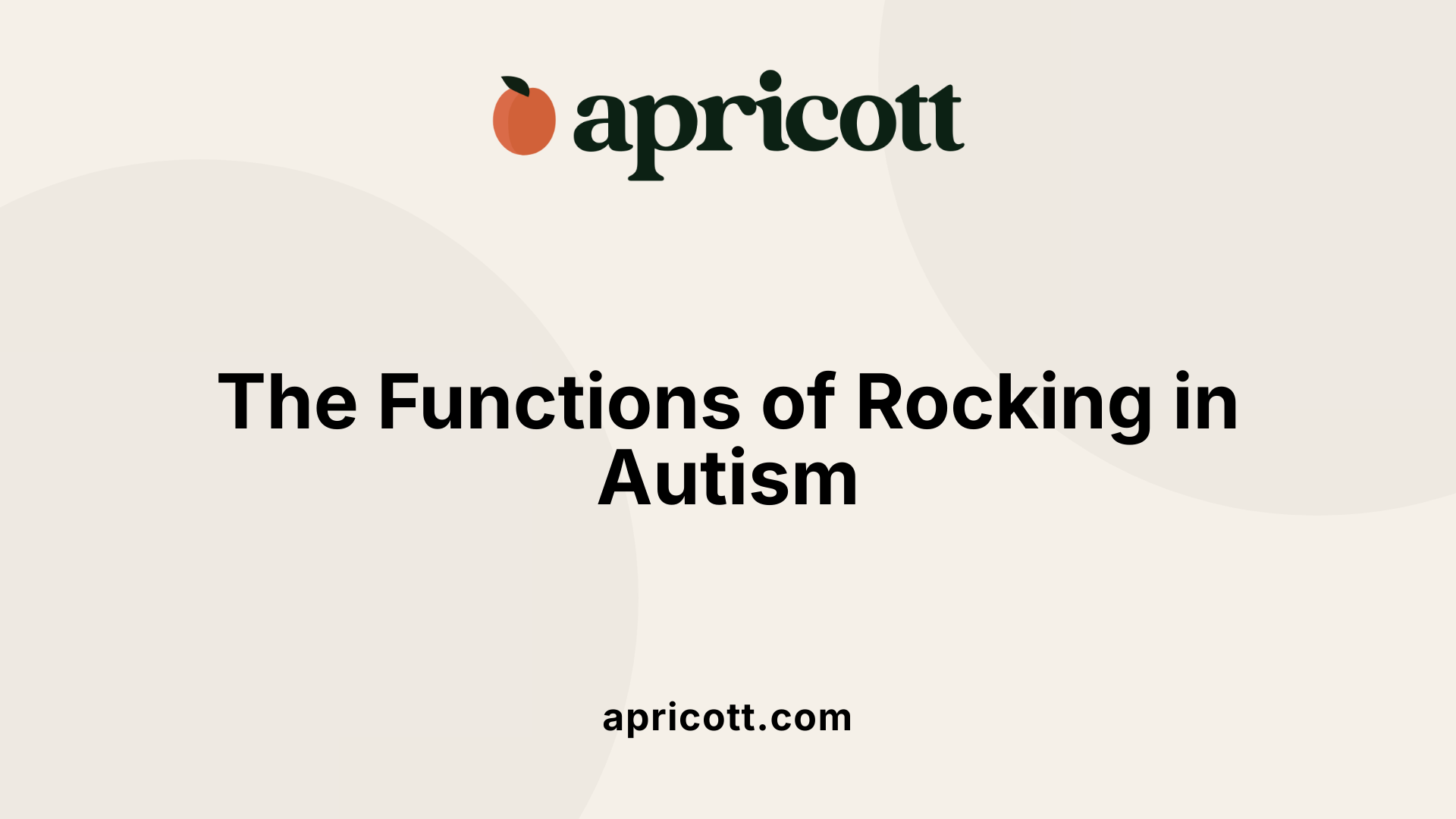Understanding the Why Behind Rhythmic Movements
Many autistic individuals engage in rhythmic behaviors such as rocking, hand-flapping, and pacing. While often observed as characteristic traits, these behaviors have deep roots in sensory processing, emotional regulation, and neurobiological functions. This article delves into why autistic people rock, exploring the underlying mechanisms, functions, associated conditions, and effective management strategies.
What Are Self-Stimulatory Behaviors in Autism?

What are self-stimulatory (stimming) behaviors in individuals with autism?
Self-stimulatory behaviors, often called 'stimming,' are repetitive movements or sounds that individuals with autism engage in to help regulate their sensory input, reduce feelings of anxiety, or express excitement. These behaviors include actions like rocking back and forth, hand flapping, spinning objects, pacing, humming, or flickering lights. The motions can involve the entire body or specific parts, and the objects manipulated may vary from toys to everyday items.
Stimming acts as a form of self-organization for sensory processing. It provides comfort during stressful moments and helps manage emotional states such as fear, nervousness, or boredom. For many autistic individuals, these behaviors serve as a coping tool to handle overwhelming environments or intense feelings.
Common forms of stimming in autism
Autistic people display a wide range of self-stimulatory behaviors. Some of the most observed include:
| Behavior Type | Examples | Purpose/Function |
|---|---|---|
| Movements | Rocking, pacing, head banging, hand flapping | Calming, sensory input regulation |
| Object manipulation | Spinning objects, flicking lights, rubbing textures | Sensory stimulation, focus |
| Vocalizations | Humming, repetitive speech, yelling | Self-soothing, communication of needs |
While these behaviors can sometimes be disruptive, they are often essential for the individual's well-being.
Purpose of stimming behaviors
Stimming serves multiple functions for individuals with autism:
- Sensory Regulation: It helps balance sensory input, either by providing additional stimulation in hypo-sensitive individuals or reducing overload in hyper-sensitive people.
- Emotional Self-Management: It alleviates feelings of anxiety, excitement, or stress, acting as a calming mechanism.
- Focus and Concentration: Some forms of stimming can support attention and engagement.
- Communication: In some cases, stimming signals internal discomfort or a need for sensory input.
Understanding these behaviors is vital for providing supportive environments. Instead of discouraging all stimming actions, caregivers and educators are encouraged to identify their purpose and develop strategies to redirect or adapt behaviors in a safe and socially acceptable manner. This approach respects the individual's needs and promotes better management of sensory and emotional challenges.
Additional considerations
While stimming is natural and often beneficial, excessive or harmful behaviors, such as head-banging or skin-picking, may require intervention to prevent injury.
Supporting individuals involves observing the triggers and functions behind their behaviors and providing alternative, safe methods for sensory regulation. Medical options, including medications, can also assist in managing associated anxiety, but professional guidance is recommended.
Overall, recognizing the importance of self-stimulatory behaviors helps foster a more accepting and inclusive approach, enhancing the quality of life and supporting better social integration and learning opportunities for autistic individuals.
The Role of Rhythmic Behaviors Like Rocking in Autism

Why do autistic individuals often engage in rhythmic behaviors like rocking?
Autistic individuals frequently engage in rhythmic behaviors such as rocking, pacing, or hand-flapping as a way to soothe themselves and regulate overwhelming sensory input. These actions provide a calming effect, helping to reduce stress, anxiety, or feelings of being overwhelmed by sensory stimuli.
Research suggests that these rhythmic movements serve a neurobiological purpose by entraining brain rhythms, which aids in sensory processing and emotional regulation. By creating predictable and repetitive motions, individuals can gain a sense of control over their environment, which is often unpredictable or overstimulating.
The Rhythmic Relating approach emphasizes that such behaviors aren't simply self-stimulating but also support social timing and reciprocal interactions. For example, rhythmic movements can facilitate turn-taking and social engagement by providing a shared rhythm that helps individuals connect more effectively with others.
Supporting this understanding, rhythm-based interventions like music therapy, dance, and rhythmic movement exercises are used to enhance communication skills, improve motor coordination, and foster emotional well-being. These methods leverage the brain's natural responsiveness to rhythm, making them effective tools for development and social integration.
In summary, rhythmic behaviors like rocking serve dual purposes: they help autistic individuals self-regulate sensory and emotional states while also supporting developmental processes related to social connection and communication.
How Sensory Processing Influences Rocking Behaviors

How does sensory processing influence rocking behaviors in autistic individuals?
Sensory processing refers to how the brain interprets information from the senses, including sight, sound, touch, and internal body signals. In autistic individuals, sensory processing differences are common and play a significant role in self-stimulatory behaviors like rocking.
Many autistic people experience hyper-sensitivity, meaning they are overly sensitive to stimuli such as bright lights, loud noises, or certain textures. For them, rocking can serve as a calming vestibular input that helps reduce feelings of overload or anxiety caused by such intense sensory experiences.
On the other hand, some individuals exhibit hypo-sensitivity, where senses are under-responsive. These individuals may rock to seek additional sensory stimulation, which they find lacks enough input to satisfy their sensory needs.
Rocking behaviors often act as a self-soothing strategy, providing a sense of physical stability and comfort amid sensory chaos. The vestibular and proprioceptive input from rocking can help regulate arousal levels and reduce distress.
Overall, these behaviors are highly personalized, reflecting each individual's unique sensory profile. Sensory processing differences influence not only the presence of rocking but also its intensity, duration, and context, shaping how autistic individuals respond and regulate their sensory environment.
Functional Purposes of Rocking Behaviors in Autism

What functions do rocking behaviors serve for autistic individuals?
Rocking behaviors in autism serve several important functions that help individuals manage their sensory environment and emotional states. One primary purpose is self-regulation and emotional regulation. When overwhelmed or anxious, many autistic individuals find that rhythmic rocking provides a calming sensory input, helping to reduce stress and maintain emotional balance.
In addition to emotional regulation, rocking acts as a form of sensory modulation. The repetitive motion stimulates the vestibular system, which is involved in balance and spatial orientation. This stimulation can help individuals gain better control over their sensory input, especially when they are experiencing sensory overload from bright lights, loud noises, or chaotic environments.
Beyond sensory and emotional regulation, rocking behaviors can also foster social connection. Some children and adults synchronize their rocking with others, which can promote feelings of bonding and communication, although this is less common among children with autism. For many, these behaviors are naturally self-soothing actions that serve as coping mechanisms during times of stress or sensory overload.
Overall, rocking behaviors play a vital role in helping autistic individuals navigate their internal and external worlds. They support emotional wellbeing, provide sensory input that can be calming or organizing, and occasionally assist with social engagement, making them an essential part of managing everyday challenges.
Associated Conditions and Therapeutic Strategies for Rhythmic Movements
Are there associated conditions or treatments related to rhythmic movements in autism?
Rhythmic movements such as body rocking, head banging, or rolling are common in autistic individuals and are often linked to sensory processing differences and motor challenges. These behaviors, categorized under sleep-related rhythmic movement disorder (RMD), usually serve as a way to soothe or regulate sensory input.
RMD typically affects children before age 3 and tends to diminish as children grow older. It occurs mainly during light or non-REM sleep and may last minutes to hours. Besides autism, RMD can be associated with other conditions like ADHD, Tourette syndrome, Rett syndrome, Angelman syndrome, and sleep apnea.
To address these rhythmic behaviors, various therapies are used. Rhythm-based interventions, including auditory rhythmic cueing, music therapy, and rhythmic relating, focus on improving motor control and coordination. These therapies activate brain areas involved in movement and social timing, fostering neural plasticity.
Research indicates that exposing individuals to rhythmic stimuli can enhance communication, social skills, and emotional regulation. For example, dance and music therapy have shown medium to large benefits for social interaction and joint action tasks.
Other conditions linked with rhythmic movements
- ADHD
- Tourette syndrome
- Rett syndrome
- Angelman syndrome
- Sleep apnea
These conditions often feature overlapping motor and sensory symptoms, making early diagnosis and tailored interventions crucial.
Effective treatments and therapies
Beyond rhythm-based therapies, safety precautions, maintaining regular sleep routines, and avoiding triggers are important. In severe cases, medications like clonazepam or melatonin may be prescribed. These aim to reduce the intensity and frequency of rhythmic behaviors.
Overall, combining behavioral strategies with rhythm-focused therapies can help improve safety, motor skills, and quality of life for individuals experiencing rhythmic movement issues related to autism.
Differences Between Autism and Other Conditions Like ADHD in Stimming Behaviors
Stimming behaviors are common in both autism and ADHD but serve different purposes and exhibit distinct characteristics.
In autism, self-stimulatory actions such as hand flapping, rocking, spinning objects, and flickering lights tend to be repetitive, rhythmic, and focused on self-regulation. These behaviors help individuals manage sensory overload, regulate their emotional states, and cope with stress or anxiety. For example, rocking back and forth can provide vestibular stimulation that calms the nervous system, and repetitive hand movements may reduce feelings of being overwhelmed.
On the other hand, individuals with ADHD often engage in stim behaviors like fidgeting, tapping, doodling, or bouncing their legs. These actions are generally more varied and less rhythmic. Their primary aim is to increase arousal, sustain focus, or combat boredom—driven by low dopamine levels that make it challenging to stay engaged or calm.
While both groups use stimming to self-soothe, the triggers and intents behind these behaviors differ. Autism-related stim behaviors are often linked to sensory sensitivities and emotional regulation, helping individuals find comfort amid sensory overload or emotional distress. ADHD stim behaviors, however, are more connected to hyperactivity and impulse control, aiding concentration and passing time.
The implications for support strategies are significant. For individuals with autism, understanding that stimming can be a necessary form of self-regulation guides caregivers to develop supportive interventions that respect these behaviors while providing alternatives if needed for safety or social appropriateness. In ADHD, managing stim behaviors involves encouraging activities that help sustain focus without disruptive hyperactivity.
Research shows that although these behaviors may look similar, nuanced differences in motivation and context are crucial for tailoring effective interventions. Recognizing whether stim behaviors aim to calm sensory input or to increase alertness enables personalized support plans, improving overall well-being and functioning.
Below is a comparison table illustrating the distinctions:
| Behavior Aspect | Autism-Related Stimming | ADHD-Related Stim Behaviors | Commonalities | |---|---|---|---| | Typical Actions | Hand flapping, rocking, spinning objects | Fidgeting, tapping, doodling | Repetitive, self-stimulatory | | Purpose | Sensory regulation, emotional calming | Increasing arousal, focus, boredom management | Both aid self-soothing | | Trigger | Sensory overload, emotional distress | Boredom, hyperactivity, impulsivity | Can be triggered by environmental factors | | Rhythm and Pattern | Usually rhythmic and predictable | Less rhythmic, more sporadic | Both self-directed | | Response to Environment | Sensitive to sensory input | Driven by need for stimulation | | Support Focus | Minimize harm, respect self-regulation | Manage hyperactivity, encourage focus | | Understanding and Support | Tailored to sensory needs | Focused on attention regulation |
Knowing these differences helps caregivers and professionals develop environment-specific strategies that respect the individual's needs and facilitate better support.
Using Knowledge of Rocking for Support and Behavior Management
Recognizing triggers
Understanding why a person with autism exhibits rocking behaviors can greatly improve how caregivers and educators respond. Rocking is often a self-soothing activity that helps regulate sensory input and emotional states. Common triggers include stress, overstimulation, fatigue, or anxiety. Identifying specific situations or environments that prompt rocking enables caregivers to minimize exposure to stressors or prepare the individual beforehand. For example, if a noisy, crowded environment leads to increased rocking, providing a quiet space or using sensory tools can help mitigate the need to self-stimulate.
Teaching alternative behaviors
Replacing rocking with other acceptable behaviors that serve the same calming function is crucial. For instance, deep pressure activities, squeezing a stress ball, or using weighted blankets can provide similar sensory input without disruptive movements. Visual supports like picture schedules or social narratives can also help children understand expected behaviors and improve their comfort in different settings. Reinforcing these alternatives through praise or rewards encourages their adoption and effectiveness.
Strategies for redirection and support
When redirection is necessary, limiting attention to the rocking behavior prevents reinforcing it as a source of comfort. Instead, offering engaging sensory activities or brief breaks can redirect the focus without creating frustration. Maintaining consistent routines and providing a predictable environment can reduce anxiety that may lead to rocking. Additionally, understanding that stress might cause an individual to revert to this behavior underscores the importance of emotional regulation techniques, such as relaxation exercises or calming routines. In some cases, medical consultation can support management, especially if anxiety or other factors significantly influence the behaviors.
By recognizing the purpose behind rocking and addressing existing triggers, caregivers can foster a supportive environment. This approach facilitates emotional regulation, minimizes disruptions, and nurtures social and learning opportunities, leading to improved overall well-being for individuals with autism.
Fostering Understanding and Support for Rhythmic Behaviors
Recognizing the multifaceted functions of rocking and other stim behaviors in autism helps caregivers, educators, and therapists provide more compassionate and effective support. Understanding these behaviors as self-regulatory tools rooted in sensory processing and emotional needs allows for tailored interventions that promote well-being, social inclusion, and development. By respecting sensory differences and utilizing rhythm-based strategies, we can help autistic individuals find calming, connection, and confidence in managing their sensory world.
References
- Reducing Self-stimulatory Behaviors in Individuals with ...
- Sleep-related Rhythmic Movement Disorder (RMD)
- Autism and sensory processing
- What is Autism Rocking Back and Forth?
- Mom perplexed by toddler stimming
- What Is Stimming in ADHD and Autism?
- What is Stimming & Is it Normal in Those Living With ASD?
- Sensory issues
- Stimming: What Is It and Does It Matter?
.svg)
.svg)








